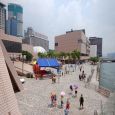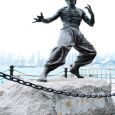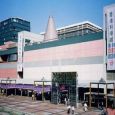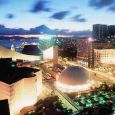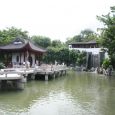Kowloon
Advertisement
By ferry
Riding the Star Ferry from Central or Wan Chai ferry piers is considered a "must-do" for any traveller to Hong Kong. Not only is this the cheapest way to traverse the harbour, it's also the finest way to go sight-seeing, particularly at night, where you're surrounded by a wall of lights and skyscrapers on both sides. If you're feeling posh, you can pay fractionally more and travel as an upper-deck passenger. Alternatively, you can travel steerage and maybe get a glimpse into the noisy engine room.
By train
The Airport Express takes you to Kowloon MTR station in just 20 minutes. Most of Hong Kong's rail lines converge on Kowloon. If you are travelling from Hong Kong island, change at Admirality on the Island Line for the MTR to Tsim Sha Tsui from Hong Kong island. The MTR to Tsim Sha Tsui offers a faster service and is the most popular choice for commuters, so avoid Admiralty interchange during the rush hour (5 PM to 7 PM). Alternatively the section of Tseung Kwan O Line between Quarry Bay and Yau Tong can be used for crossing the harbour.
By taxi
Taking a taxi across the harbour to Kowloon can be slow and expensive due to traffic. Some taxi drivers operate only on one side of the harbour, so you may have to find a taxi rank marked "Cross-harbour trips only." Expect to pay tunnel fees both ways unless you depart from a taxi rank dedicated to cross-harbour service.
By helicopter
Helicopter transfers can be arranged between Hong Kong International Airport and the roof-top landing pad at the Peninsula Hotel in Tsim Sha Tsui.
By bus
Citybus Cityflyer provides several bus routes from the Airport terminal, including A21, A22. Although they take longer time than MTR Airport Express, the fare of buses is much cheaper than the Airport express and they calls on much frequent bus stops along areas include Mong Kok, Tsim Sha Tsui, as well as nearby some hotels.
Advertisement
The Kowloon Waterfront
The Kowloon Waterfront offers splendid views of the Hong Kong island shore and skyline. This is the best place to experience the classic view of Hong Kong, and nobody on their first trip here should miss out on promenading along the waterfront. The best views are to be had at night when the lights of global capitalism provide a powerful spectacle. If you are not proficient with night-time photography, you can pay a modest sum for a professional to take your photograph against one of the world's most iconic backdrops. Start at the Star Ferry terminal, and begin your walk by inspecting the historic clock tower which is all that remains of a railway station that once took colonial officials back to London via the Trans-Siberian railway.
A Symphony Of Lights
A Symphony Of Lights Every night at 8 PM there is a colourful light show that is staged atop the key buildings on both sides of the harbour. On Monday evenings, spectators can listen to the show's music and English narration live at the Avenue of Stars, on radio on FM103.4 MHz
Avenue of the Stars.
Avenue of the Stars If you continue your stroll along the Tsim Sha Tsui waterfront you will soon find yourself walking along Hong Kong's version of Hollywood's walk of fame. You have to look down to appreciate the Avenue of the Stars where so many local film stars have pawed the wet concrete. You might not recognise their names, but it goes to show how big Hong Kong's film industry is. The experience is targeted at tourists from mainland China and the piped music gives it a slightly cheesey feel, but the statue of film legend, Bruce Lee, provides a welcome photo opportunity even for those who might know very little about Cantonese cinema.
Hong Kong Museum of Art
The entrance lies up one floor, mimicking the “temple” approach to the high altar of culture and art. Once you arrive on the first floor, you are bathed in light from the wall of glass that gives you a panoramic view of Hong Kong Island. The objects on show are Chinese ceramics, terracotta, rhinoceros horn and Chinese paintings. There is also a temporary exhibition space devoted to items from their own collection with additional lent material. There is also space for contemporary art produced by Hong Kong artists, most of whom have moved away from the traditional Chinese art forms to fusion art with North American and British influence, reflecting Hong Kong's colonial past. $10, concessions $5
Dialogue in the Dark
An exhibition in complete darkness. Experience five different Hong Kong themed environments using your non-visual senses with the help of a visually impaired guide. Reservations in advance are recommended.
Hong Kong Science Museum
Large museum with many interactive exhibits including a energy machine and an airplane. A museum which decided to make an architectural statement about its purpose, yet somehow got it horribly wrong. This museum is primarily aimed at children. The maths puzzles and optical illusions on the top floor are challenging. There is a giant Rube Goldberg machine spanning the entire museum that is run for a few minutes every two hours. $35 (permanent exhibitions only $25).
Hong Kong Space Museum
Quite a small museum, with a basic history of space flight in static exhibits, including a single exhibit on Chinese space flight. It also has interactive exhibits, allowing you to fly a hang glider, work a space motion system, and simulate walking on the moon. The museum has a planetarium attached that shows movies projected onto the planetarium roof. Plan ahead if you want to ensure you see an English session, as most are Cantonese. It is fun for kids aged around 10 to 15 years. Admission is free on Wednesday
Kowloon Walled City Park
When the British returned after the war, the Walled City remained notorious for drugs, vice and many things shady and criminal. Here, triad gangs operated alongside dodgy dentists and refugees escaping the cultural revolution. In 1987, after so many years of being beyond the reach of the law, the colonial government, in consultation with the Beijing authorities, made the bold decision to raze the place to the ground. Sadly, the park that remains is very tame in comparison to its distinctive history, but it does offer a few clues and remnants from its colourful past.
Information not available
Information not available
Advertisement

